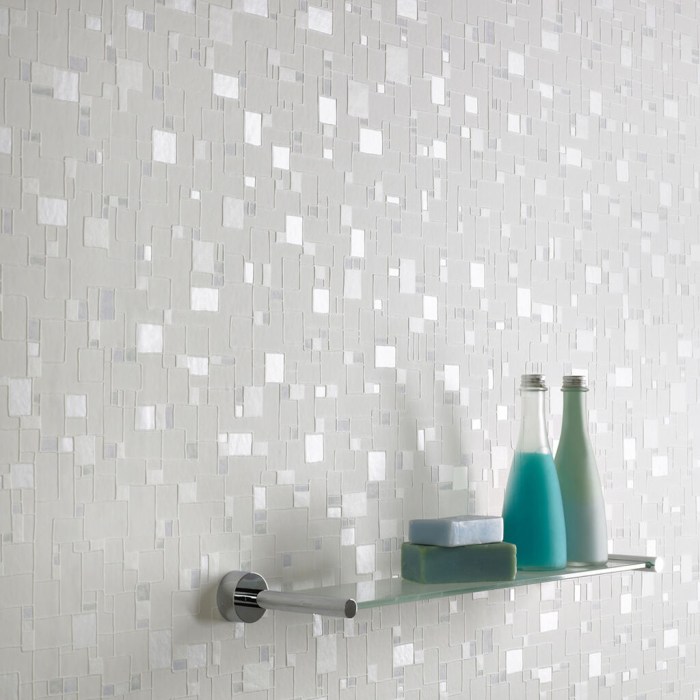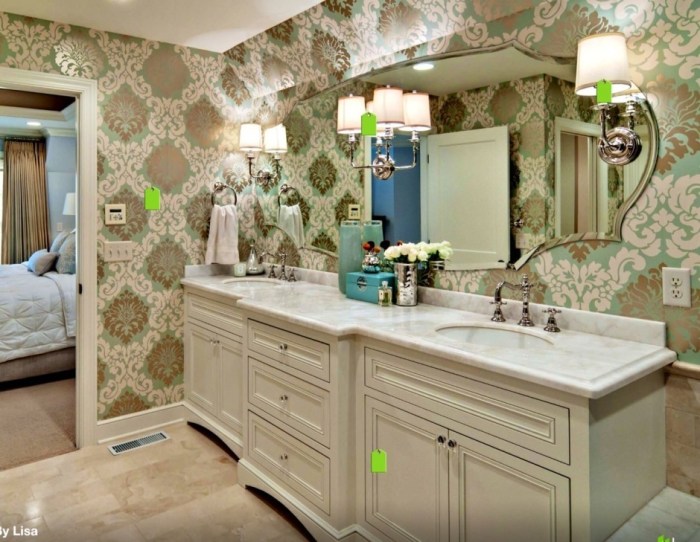Bathrooms, often the smallest rooms in our homes, offer a unique opportunity to express our creativity and style. In recent years, water-resistant wallpaper tiles have emerged as a revolutionary solution for bathroom decoration, offering both functionality and aesthetic appeal.
These innovative tiles combine the durability of traditional tiles with the versatility and ease of installation of wallpaper, making them an ideal choice for both homeowners and professionals seeking to transform their bathrooms into stylish and practical spaces.
Introduction to Water-Resistant Wallpaper Tiles
Water-resistant wallpaper tiles are innovative and practical solutions for bathroom decoration. They are composed of durable materials that effectively resist moisture and water damage, making them ideal for humid environments like bathrooms. Unlike traditional tiles, wallpaper tiles offer a hassle-free installation process and can be easily applied to walls without the need for professional assistance or specialized tools.
Benefits and Applications of Water-Resistant Wallpaper Tiles
Water-resistant wallpaper tiles provide numerous advantages over traditional tiles. They are lightweight, flexible, and can be cut to fit any shape or size, allowing for maximum customization and seamless integration into various bathroom designs. Additionally, they are resistant to stains, scratches, and fading, ensuring longevity and a pristine appearance over time.
Types of Water-Resistant Wallpaper Tiles
Water-resistant wallpaper tiles come in various materials, each with its unique properties and characteristics. Understanding these differences helps you choose the best tiles for your bathroom decor.
The most common materials used in water-resistant wallpaper tiles include:
PVC (Polyvinyl Chloride)
PVC tiles are durable, affordable, and easy to install. They are made of a synthetic polymer that resists moisture and stains. PVC tiles come in a wide range of designs and patterns, including faux stone, wood, and ceramic looks.
Vinyl
Vinyl tiles are similar to PVC tiles but offer a more premium look and feel. They are made of a thicker, more flexible material that is resistant to scratches and fading. Vinyl tiles are available in various designs, including realistic wood, marble, and tile patterns.
Polyethylene Terephthalate (PET)
PET tiles are lightweight, flexible, and highly water-resistant. They are made of a polyester-based material that is resistant to mold and mildew. PET tiles are often used in high-moisture areas such as showers and bathtubs.
Fiberglass
Fiberglass tiles are durable, fire-resistant, and water-resistant. They are made of a woven fiberglass mesh that is coated with a waterproof resin. Fiberglass tiles are often used in commercial settings such as hospitals and restaurants.
Design Considerations for Bathroom Decoration
When selecting water-resistant wallpaper tiles for bathroom decoration, consider factors such as:
- Moisture Resistance: Opt for tiles with a high moisture resistance rating to withstand bathroom humidity and prevent water damage.
- Style: Choose tiles that complement the overall bathroom décor and personal preferences, from classic patterns to modern designs.
- Size and Shape: Consider the size and shape of the tiles to create a desired aesthetic, such as using larger tiles for a spacious look or smaller tiles for intricate patterns.
- Texture: Explore tiles with different textures, such as smooth, embossed, or textured, to add depth and visual interest to the bathroom.
- Maintenance: Select tiles that are easy to clean and maintain, ensuring a pristine bathroom environment.
Creating Visually Appealing Designs
To create visually appealing bathroom designs with water-resistant wallpaper tiles, consider the following tips:
- Focal Point: Create a focal point by using tiles in a contrasting color or pattern on a specific wall or area, drawing attention to a particular feature.
- Pattern Play: Experiment with different tile patterns to add visual interest and break up monotony, such as mixing solid-colored tiles with patterned tiles.
- Accent Wall: Designate one wall as an accent wall by using a different tile pattern or color to create a bold statement and add depth to the bathroom.
- Borders and Trim: Use borders and trim tiles to frame the tiled area and add a touch of sophistication and definition.
- Lighting: Enhance the visual appeal of the tiles by using appropriate lighting to highlight their textures and patterns, creating a warm and inviting ambiance.
Incorporating Wallpaper Tiles into Existing Décor
To seamlessly incorporate water-resistant wallpaper tiles into existing bathroom décor:
- Match Color Scheme: Select tiles that complement the existing color scheme of the bathroom to create a cohesive look.
- Complement Patterns: If the bathroom already has patterns, choose tiles with complementary patterns to avoid overwhelming the space.
- Consider Textures: Explore tiles with textures that harmonize with the existing bathroom décor, creating a visually pleasing and balanced environment.
- Add Contrasts: Introduce tiles in contrasting colors or patterns to create a focal point and add visual interest to the bathroom.
- Seek Professional Help: If unsure about incorporating tiles into the existing décor, consult with a professional interior designer for guidance.
Installation and Maintenance of Water-Resistant Wallpaper Tiles
Installing water-resistant wallpaper tiles in your bathroom can be a rewarding project that enhances the aesthetics and functionality of the space. With proper preparation, application, and maintenance, these tiles can provide a durable and stylish solution for years to come.
The installation process involves several steps:
Preparation
- Ensure the surface is clean, dry, and free of any dust, dirt, or debris.
- If necessary, apply a primer to the surface to improve adhesion.
- Measure and mark the area where the tiles will be installed.
Application
- Apply adhesive to the back of the tiles using a notched trowel.
- Press the tiles firmly onto the surface, aligning them with the marked lines.
- Use a damp sponge to remove any excess adhesive.
- Allow the adhesive to dry completely before using the bathroom.
Finishing
- Apply grout between the tiles to fill any gaps and create a seamless look.
- Use a damp sponge to clean any excess grout.
- Seal the tiles with a clear sealant to protect them from water damage.
Maintenance and cleaning are crucial to ensure the longevity of water-resistant wallpaper tiles. Here are some tips:
Maintenance
- Wipe down the tiles regularly with a damp cloth.
- Avoid using abrasive cleaners or sponges.
- Inspect the tiles periodically for any damage or wear.
Cleaning
- For deeper cleaning, use a mild soap solution and a soft brush.
- Rinse the tiles thoroughly with clean water.
- Dry the tiles with a soft cloth.
By following these installation and maintenance guidelines, you can enjoy the beauty and durability of water-resistant wallpaper tiles in your bathroom for years to come.
Comparison with Traditional Tiles
Water-resistant wallpaper tiles and traditional tiles both have their advantages and disadvantages. To make an informed decision for your bathroom decoration, consider the following factors:
Cost: Traditional tiles are generally more expensive than water-resistant wallpaper tiles. However, the cost of installation should also be factored in.
Durability: Traditional tiles are more durable than water-resistant wallpaper tiles. They are less likely to be damaged by water, heat, or wear and tear.
Ease of installation: Water-resistant wallpaper tiles are easier to install than traditional tiles. They can be applied directly to the wall without the need for grout or mortar.
Design flexibility: Water-resistant wallpaper tiles offer more design flexibility than traditional tiles. They come in a wide range of colors, patterns, and textures.
Pros and Cons
Pros of water-resistant wallpaper tiles:
- Cost-effective
- Easy to install
- Design flexibility
Cons of water-resistant wallpaper tiles:
- Less durable than traditional tiles
- May not be suitable for all bathroom environments
Pros of traditional tiles:
- Durable
- Suitable for all bathroom environments
Cons of traditional tiles:
- More expensive
- Difficult to install
- Less design flexibility
Case Studies and Examples
Witness the transformative power of water-resistant wallpaper tiles through real-world examples of successful bathroom renovations. Before-and-after photos will showcase the remarkable results, and testimonials from satisfied customers will attest to the durability and aesthetic appeal of these innovative tiles.
Renovation of a Small Bathroom
A compact bathroom underwent a dramatic transformation using water-resistant wallpaper tiles. The original white tiles had become dull and outdated, creating a cramped and uninspiring space. The new tiles, featuring a subtle geometric pattern in shades of gray and white, instantly refreshed the look of the bathroom, making it appear larger and brighter.
The tiles’ water resistance ensured their longevity in the humid environment.
“I couldn’t believe how much difference the new tiles made. My bathroom went from drab to fab in just a few hours. The tiles are so easy to clean, and I love that I don’t have to worry about water damage.”
Sarah, satisfied customer
Upgrade of a Master Bathroom
A spacious master bathroom received a luxurious upgrade with the installation of water-resistant wallpaper tiles. The original marble tiles were cold and impersonal, but the new tiles, featuring a warm wood-like texture, created a cozy and inviting atmosphere. The tiles’ water resistance allowed for a seamless transition between the shower and the rest of the bathroom, eliminating the need for separate shower curtains or glass doors.
“We love our new bathroom! The tiles are stunning, and they’ve made such a difference in the overall look and feel of the space. They’re also so easy to clean and maintain, which is a huge plus.”
John, satisfied customer
Trends and Innovations
The world of water-resistant wallpaper tiles is constantly evolving, with new trends and innovations emerging all the time. These tiles are becoming increasingly popular due to their versatility, durability, and ease of installation. As a result, manufacturers are investing heavily in research and development to create new and improved products.
One of the most significant trends in water-resistant wallpaper tiles is the development of new materials. Traditional tiles are typically made from ceramic or porcelain, but new materials such as vinyl, acrylic, and even metal are now being used. These new materials offer a number of advantages over traditional tiles, including greater flexibility, lighter weight, and improved water resistance.
Another trend in water-resistant wallpaper tiles is the development of new designs. Traditional tiles are often plain or have simple patterns, but new tiles are now available in a wide range of colors, patterns, and textures. This makes it easier than ever to find tiles that match the style of your bathroom.
Finally, new technological advancements are also making water-resistant wallpaper tiles more versatile and easier to install. For example, some tiles now come with self-adhesive backing, which makes installation a breeze. Other tiles are designed to be interlocking, which eliminates the need for grout.
Future Applications and Possibilities
The future of water-resistant wallpaper tiles is bright. As new materials and technologies continue to be developed, these tiles will become even more versatile, durable, and easy to install. This will make them an even more popular choice for bathroom decoration.
In addition to traditional bathroom applications, water-resistant wallpaper tiles can also be used in a variety of other applications, such as kitchens, laundry rooms, and even outdoor areas. As the technology continues to improve, these tiles are likely to become even more popular in the years to come.
Last Word
As we look towards the future, water-resistant wallpaper tiles continue to evolve, promising even more exciting possibilities for bathroom decoration. Their versatility, durability, and ease of use make them an indispensable tool for creating beautiful and functional bathrooms that will stand the test of time.




